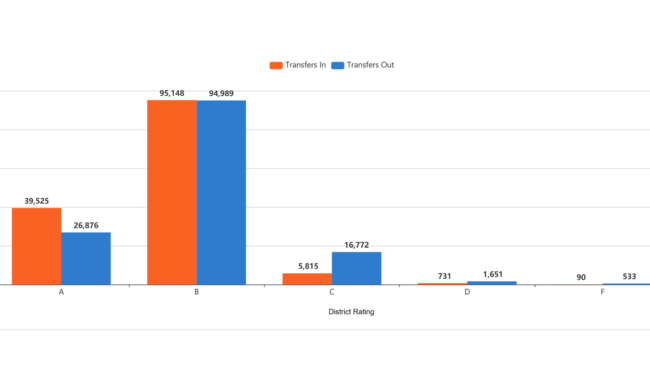Many state legislatures across the country are looking to reform antiquated education funding policies that govern how students can transfer to schools across residentially-assigned school district boundaries.
In most states, it is difficult or impossible to obtain data on student transfers and the rate at which students are allowed to attend a public school that is outside of their assigned school district’s boundaries. Although Texas still has room to improve in its own reporting measures, the state is ahead of most of its peers in this regard and the school transfer data they do make available can help to assess if the state’s families have adequate educational opportunities outside of their own residentially-assigned school districts.
Student transfer policies like this are commonly referred to as open enrollment and research shows that families use open enrollment for varied reasons, including to access specialized programming and to escape bullying.
Reason Foundation and Texas Public Policy Foundation created the Texas Student Transfer Dashboard, to help shine a light on the state’s open enrollment trends. The dashboard unearthed a few key findings regarding student transfers in Texas.
First, there is strong demand for open enrollment. Three percent of Texas students transferred to a school outside of their home school district in the 2018-19 school year, which means that about 164,000 students benefitted from educational opportunities across district lines.
For comparison, the student population that transferred out of their home district represents a little more than half of the state’s charter student population in the 2018-2019 school years.
The Reason Foundation-TPPF analysis also revealed that students are transferring into higher-performing school districts and out of lower-performing ones, which holds true when looking at statewide and metro area data.
The chart below shows transfer trends categorized by school district accountability grade. For example, 39,525 students transferred into A-rated school districts while 26,876 transferred out, representing about 3.8 percent and 2.6 percent of these districts’ populations, respectively. Overall, transfers into school districts are relatively higher for A-rated districts, about identical for B-rated districts, and lower for C, D, and F-rated districts—where transfers out of the school district are higher.
Similarly, it’s also useful to examine student transfer flows by accountability grade, as displayed in the chart below. For example, 91 percent of students who leave C-rated school districts transfer into school districts with an A or B rating. In aggregate, about 45,000 Texas students transferred to a higher-performing school district that was at least one letter grade above their residentially-assigned school district.
The vast majority of Texas students attend schools in B-rated districts, thus the bulk of transfers are from one B-rated school district to another. However, this is not necessarily a lateral move since districts sometimes have substantial variation in the quality of their schools, and, more importantly, accountability scores don’t always capture factors that are important to families when choosing schools. As such, even identically-rated school districts cannot be considered homogenous or interchangeable entities since all students have unique needs.
While Texas’ open enrollment data provide a glimpse at some key trends, it is clear that more transparency is needed.
Currently, it is impossible to determine the demographics of transfer students, their reason for transferring, or even the specific schools they are leaving from and going to. In fact, even basic information—including the transfer policies of more than 1,200 school districts—isn’t collected and publicly reported in a way that is easily accessible for families and policymakers.
While Texas’ open enrollment data is vastly better than most states, it still falls short of providing stakeholders with the information they need to make sound policy decisions. Steps should be taken to ensure these and other data—particularly school districts’ transfer policies—are collected and reported regularly.


